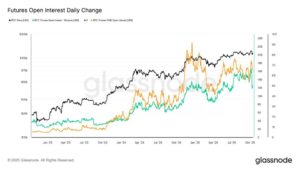Bitcoin’s Path to Recovery: Holding $114,000 Key for Investor Confidence
Bitcoin (BTC) is currently at a pivotal moment, where holding the $114,000 level is essential for instilling investor confidence and attracting new liquidity to breach the tight trading range of $110,000 – $116,000. A September 11 report from Glassnode highlights that Bitcoin has been stagnating in an "air gap" range since its peak in mid-August, with this narrow trading zone posing a significant threat to the ongoing rally. The price stagnation underscores the necessity for Bitcoin to assert its strength, as the lack of decisive movement may further stall progress, leading to increased uncertainty among market participants.
The present landscape reveals a complex interplay of buyer behavior influencing Bitcoin’s price trajectory. According to the report, there are three distinct investor cohorts shaping the ongoing market dynamics. The first group comprises top-buyers who entered the market over the past three months, holding positions around $113,800. The second group includes dip-buyers who have clustered around the $112,800 mark. Lastly, the third cohort features short-term holders from the past six months, who are anchored near $108,300, thereby creating defined support and resistance zones. This segmentation highlights the varying strategies and motivations among Bitcoin investors, which are instrumental in driving the price action.
Despite the recent bounce from the $108,000 mark, Bitcoin’s recovery underscores significant underlying market stress. Daily realized profits for seasoned short-term holders reached approximately $189 million, accounting for 79% of all short-term gains within that timeframe. Investors who acquired Bitcoin during the dips from February to May have opted to capitalize on recent price strength, further contributing to selling pressures in the market. The realization of losses among recent top buyers intensified the situation, with losses recorded at up to $152 million daily. This pattern mirrors stress behaviors observed during previous market peaks, particularly in April 2024 and January 2025, when peak buyers capitulated under similar selling pressures.
The phenomenon of loss realization is presently weighing heavily on Bitcoin’s recovery potential. The Net Realized Profit as a share of market capitalization peaked at 0.065% during the rally in August before trending lower, signaling a critical decline in market inflows and support. Although levels remain elevated, the current metric implies that the inflows are providing diminished support compared to earlier market phases. Compounding this issue is the sharp drop-off in net inflows for US spot exchange-traded funds (ETFs), which have continued to hover around 500 BTC daily since early August. This downturn removes a crucial pillar of institutional demand that previously fueled Bitcoin’s robust ascent through 2024, raising alarms about the sustainability of the current rally.
With spot flows weakening, Bitcoin’s derivatives markets have gained prominence in shaping price formation. The Volume Delta Bias, which signals seller exhaustion across major futures venues such as Binance and Bybit, indicates some recovery since the bounce from $108,000. Interestingly, the 3-month annualized futures basis remains below 10%, suggesting a measured demand for leverage without the speculative excess commonly seen during bullish market conditions. At the same time, perpetual futures volume has remained subdued, echoing post-euphoric market phases rather than aggressive speculative behavior.
The rise in Bitcoin options open interest, reaching record highs, signifies institutions increasingly utilizing derivatives for risk management purposes, including protective puts and covered calls. Coupled with declining implied volatility, this scenario paints a picture of market maturation, reflecting a reduced appetite for speculative positioning. Under these conditions, a decisive reclaiming of the $114,000 level is vital for restoring top-buyer profitability and inviting fresh institutional capital into the market. Conversely, failing to maintain this level of support could put renewed pressure on short-term holders, with critical downside targets looming at $108,300 and ultimately at $93,000—areas where significant supply clusters await.
In summary, Bitcoin’s ability to hold the $114,000 level is crucial for its prospects of breaking through the current trading range and regaining investor confidence. As conflicting forces exert pressure on the cryptocurrency, the market needs to navigate the complexities introduced by different buyer cohorts while addressing the significant selling pressures stemming from loss realizations. The weakening of institutional demand through ETF inflows further complicates the scenario. However, the resilience observed in derivatives markets may provide a degree of stability, indicating that as Bitcoin progresses, both short-term and long-term holders must keep a watchful eye on key price levels to navigate this volatile landscape effectively.



![Plasma [XPL] Soars 21% Following DeFi Partnerships, but THIS Factor Could Halt Its Momentum!](https://cryptonewsinsiders.com/wp-content/uploads/2025/10/Lennox-1-4-1000x600-300x180.png)













